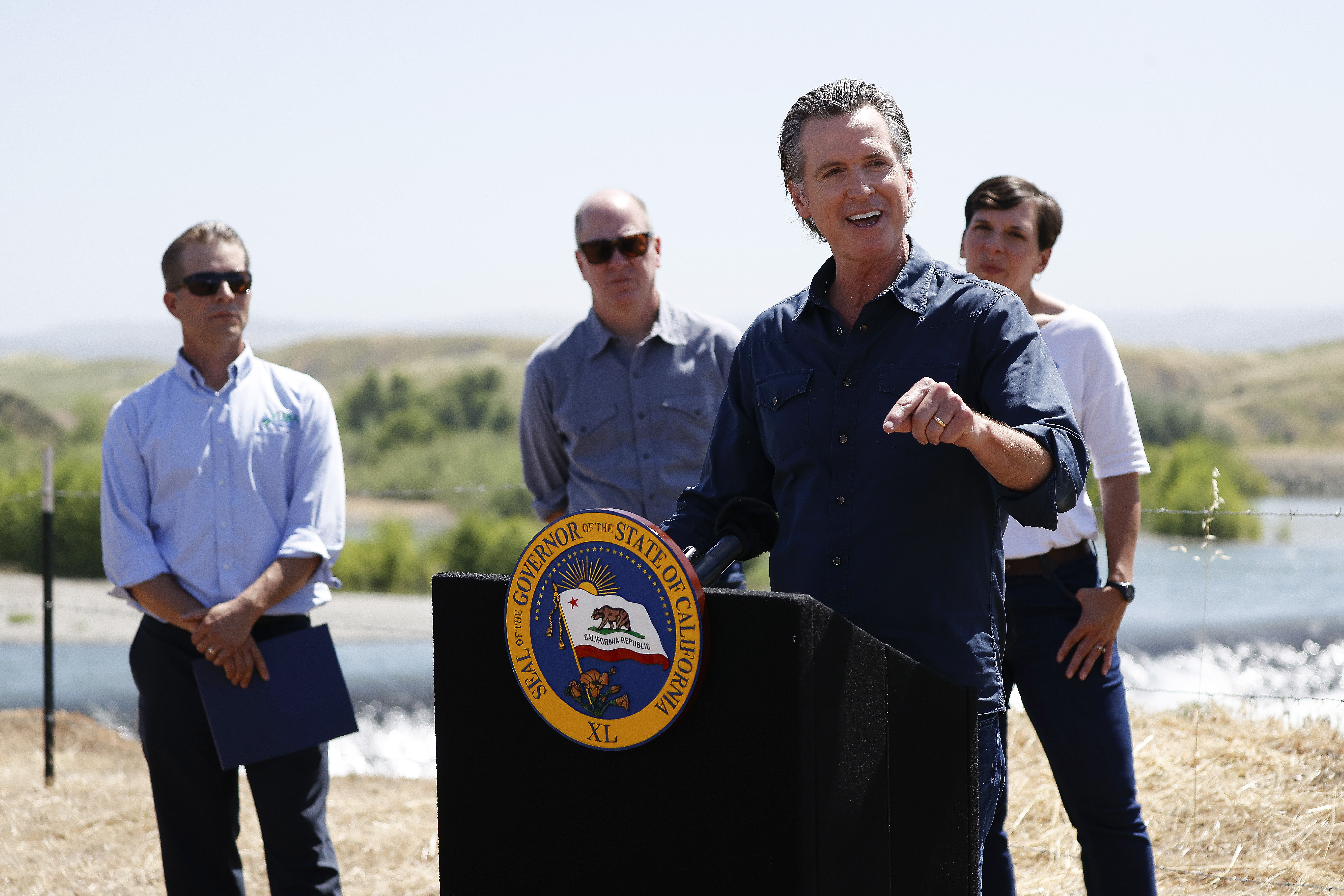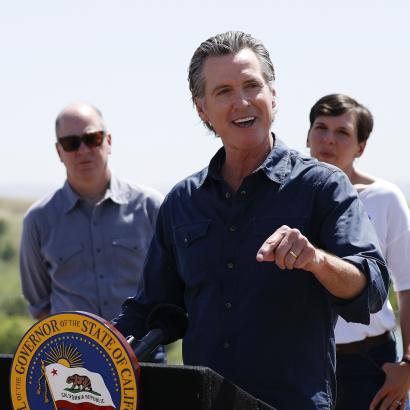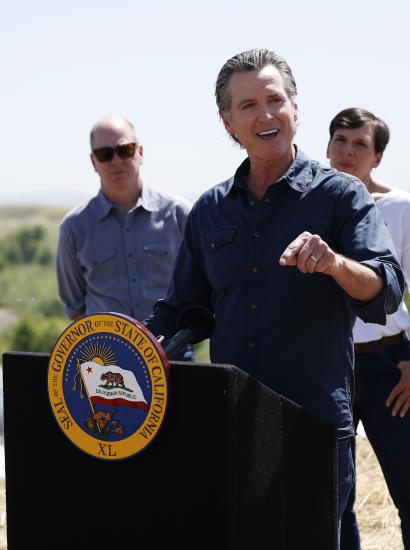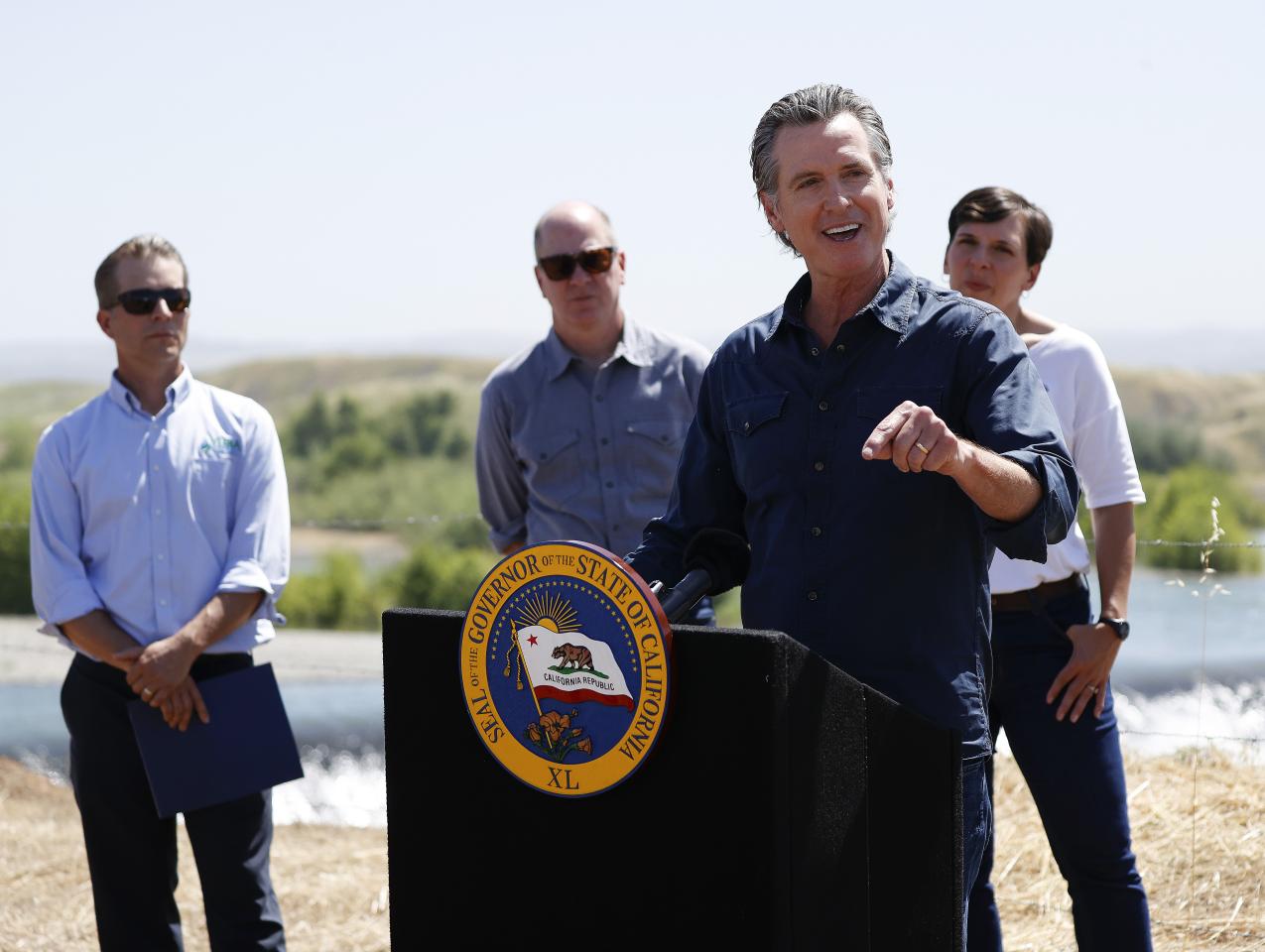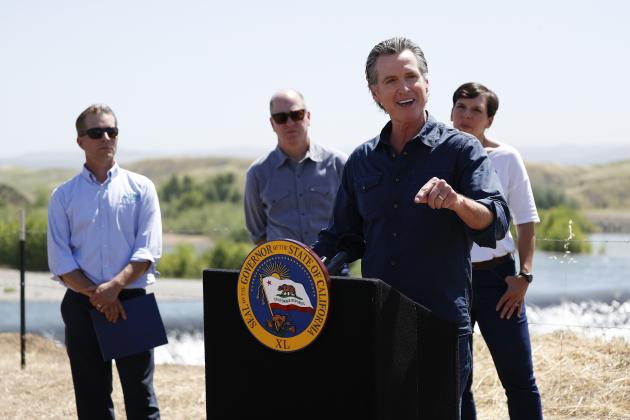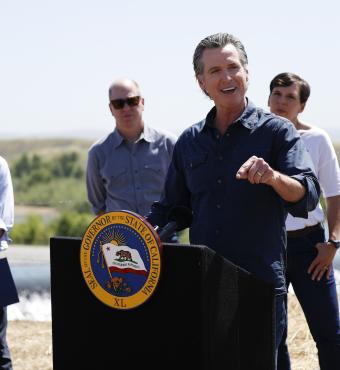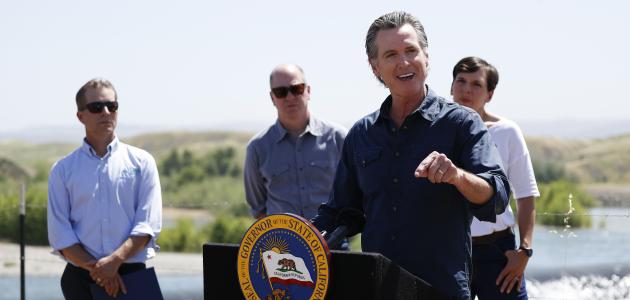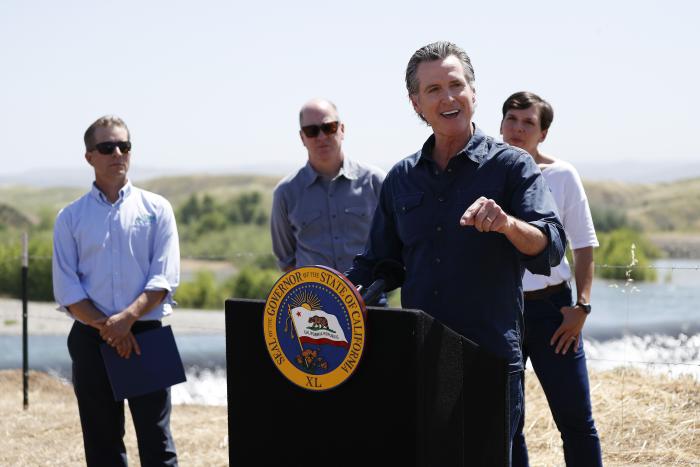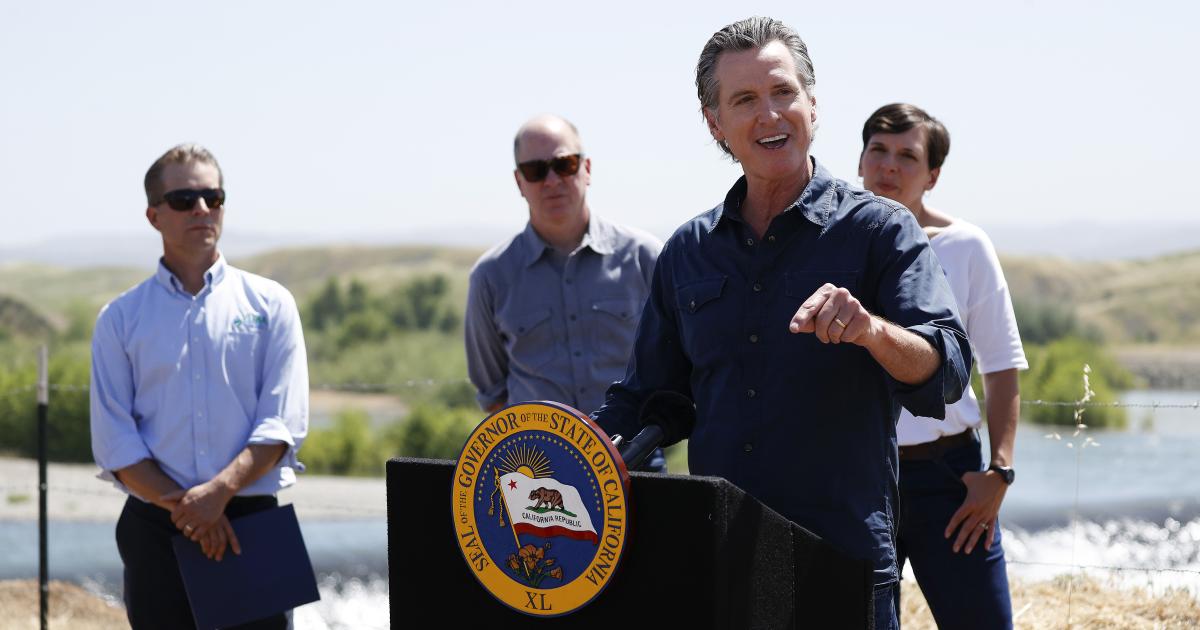- State & Local
- California
Hardcore Seinfeld viewers might recall “the summer of George” episode in the show’s eighth and penultimate season: the layabout George Costanza taking a vow to turn three months of severance pay from the New York Yankees into an action-packed hiatus between jobs, only to slowly descend into lethargy (i.e., the lounge chair with the built-in beverage cooler).
Not that America’s most populous state is to be confused with a Manhattan-based situation comedy, but California likewise is home to seasonal hijinks. In the Golden State’s case, let’s call it “the summer of Gavin.” Govenor Gavin Newsom, no layabout he, is taking advantage of a new lease on political life after Kamala Harris’s drubbing last November opened the door to a Newsom presidential run in 2028. (Newsom currently is placing second in wagers placed on Polymarket predicting the next presidential winner.)
Newsom’s presidential wanderlust includes a visit earlier this month to South Carolina—catnip for California and national media as it reeks of White House aspirations (South Carolina being the first stop on the Democratic primary trail in 2024)—even if the trip wasn’t exactly the lead story in the Palmetto State (a byproduct of Newsom’s touring rural towns rather than larger media markets, plus South Carolinians being more concerned with looming heat waves and tropical storms than a distant national election).
So how to read Newsom’s visit?
First, it was small potatoes by local Democratic standards. Newsom’s gadding about in small towns, in doing so raising a modicum of cash for the state party, pales in comparison to Maryland Governor Wes Moore’s star turn headlining the South Carolina Democratic Party’s annual Blue Palmetto Dinner back in May (Moore also visited a defense tech company, a pharmaceutical firm, and a truck factory).
Second, not all South Carolina Democrats were impressed. “He’s a very, very handsome man,” noted former State Senator Richard Harpootlian, who’s also repping Hunter Biden in a federal libel lawsuit. “But the party is searching for a left-of-moderate candidate who can articulate blue-collar hopes and desires. I’m not sure that’s him.”
Third, Newsom’s not the only California Democrat with South Carolina (and beyond) on his mind. Soon after Newsom’s visit, California Rep. Ro Khanna descended on the Palmetto State to meet with its influential black vote. (“I see the interconnection between the Indian American experience and African Americans in a deeply spiritual way,” the Silicon Valley congressman and son of immigrants told reporters.)
But fourth, and perhaps most concerning for Newsom: Whatever luggage the governor takes, there’s the baggage of his home state.
Consider this salvo courtesy of South Carolina attorney general and gubernatorial candidate Alan Wilson:
Gavin Newsom turned California into a case study in government overreach and liberal failure. From authoritarian lockdowns to sky-high taxes and rising crime, his policies crushed small businesses, undermined law enforcement, and prioritized political theater over the people he was elected to serve. . . . If Gavin Newsom wants to test his national message here, he’ll be met by a united conservative front that knows exactly what’s at stake. . . . We don’t need Gavin Newsom’s twisted version of America in the Palmetto State.
And therein lies one of Newsom’s biggest challenges should he take the presidential plunge: Can he sell California as a piece of the American Dream as opposed to the stuff of woke, progressive nightmares?
To date, the Newsom strategy is to vigorously counterpunch attacks on his record—even if he’s punching below his weight. Case in point: this social media spat with South Carolina Rep. Nancy Mace, who’s hardly a heavyweight in national Republican circles.
After Mace’s warning of “Don’t California my South Carolina” (a phrase previously coined by Texas Gov. Greg Abbott), Newsom replied with a string of California virtues (“lower homicide rates,” “higher GDP,” and so forth), ending with this shot: “Time for a bathroom break, Nance.”
The problem with the governor’s newfound and sophomoric embrace of online slap-fighting: It’s beneath Newsom’s political stature (he may be president one day; Mace has never held a statewide office).
Moreover, it’s beneath the dignity of a governor’s office.
Take, for example, Newsom’s denigration of Trump White House aide Stephen Miller in this July 11 tweet. “This fascist cuck in DC continues his assault on democracy and the Constitution, and his attempt to replace the sovereignty of the people with autocracy. Sorry the Constitution hurt your feelings, Stephen. Cry harder.”
Or, a day later, Newsom tearing into Vice President JD Vance (ok, he’s at least the governor’s political peer, if not superior) with this tweet when the vice president brought his family to California for a Disneyland visit: “JD is back in California. He won’t take the time to debate and defend gutting our Medicaid system, taking away kids school meals, militarizing America’s streets, or adding trillions to the debt. Instead, he’s off to Disneyland. Probably to detain Mickey Mouse at this rate.”
As a friend and fellow Californian reminded me after reading that missive: “A leader would have said, ‘All visitors to California are welcome to enjoy Disneyland. The first Disney theme park in the world.’”
What to expect next from Newsom as summertime dwindles? Perhaps what would arguably be the riskiest move of his political career: fiddling with California’s redistricting process.
After Texas Republicans opted to redraw their state’s congressional districts in this month’s special legislative session in order to help preserve the GOP’s narrow majority in the US House of Representatives, Newsom pounced on the controversy, threatening to do the same in California with a legislature under Democratic supermajority control.
The problem with the governor’s bravado: California’s legislature doesn’t draw district maps. Instead, the responsibility belongs to an independent redistricting commission established by 2008’s Proposition 11 (congressional districts falling under the commission’s jurisdiction, much to Nancy Pelosi’s chagrin, courtesy of 2010’s Proposition 20).
So how would Newsom get around that technicality? By having the legislature call a special election and convince California voters to amend the state constitution.
“I’m talking to members of my legislature, whatever our alternatives, we could do a special session,” Newsom claimed in a Pod Save America interview. “I could call for one today, if I chose to, we could then put something on the ballot, and I could call a special election. We can change the [state] constitution with the consent of the voters, and I think we would win that. I think people understand what’s at stake in California.”
What Newsom claims is indeed feasible—although the legislature would have to move posthaste. Under state law, a constitutional amendment can’t be put to a vote until the first statewide election that happens at least 131 days after its legislative approval. But given that candidates for California’s June 2026 primary faced a March 2026 filing deadline in contests theoretically involving redrawn districts, that requirement likely would be waived, as it was for another special election back in 2005 (more on that a moment).
On the other hand, the governor may want to study recent California history and its mixed results with regard to special elections.
In November 1973, then-Governor Ronald Reagan called a special election and an up-or-down vote on Proposition 1, limiting the taxing powers of state and local government. It lost by a near landslide.
Thirty-two years later, then-Governor Arnold Schwarzenegger tried something even more ambitious: a special election featuring four reform ideas that poked at various political monopolies (one of those measures pertaining to redistricting). All four were soundly defeated.
While California governors have scored successes in special elections (in 1993, then-Governor Pete Wilson got his way with the approval of Proposition 172 and a half-cent sales tax for public safety), it’s a political roll of the dice—maybe more so for Newsom, given his track record of late when he’s offered himself as the public face of statewide ballot measures. (Those include, in 2020, voter rejection of a $15 billion state school bond, as well as the skin-of-its-teeth approval of Proposition 1 to combat homelessness in California’s March 2024 primary.)
For Newsom, losing a special election would be a humiliating way to kick off an eighth and final year in office—unless the goal is not so much winning or losing in California as it is currying favor with that element of his party that yearns to do battle with the Trump presidency (Trump’s political advisors having pressured Texas to fiddle with its congressional maps), and which will turn out in great numbers in 2028’s presidential primaries and caucuses.
In which case, Newsom could be a political “winner” regardless of the special election’s outcome.
And California?
Seinfeld’s George Costanza again comes to mind—specifically, an episode from earlier in season eight featuring the art of screening calls (to the tune of the theme song from The Greatest American Hero, Costanza’s phone message being the very annoying “Believe it or not, George isn’t at home”).
Sure, Gavin is back from South Carolina.
But is California’s governor really at home, or is his mind in other states?







